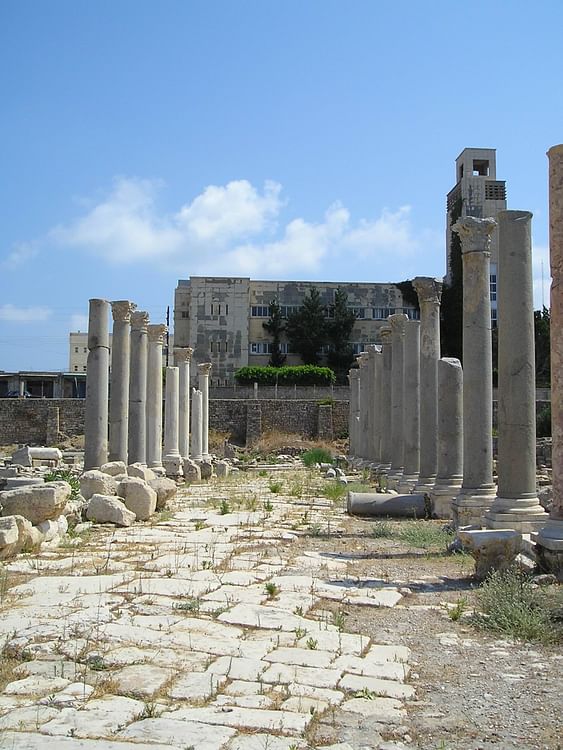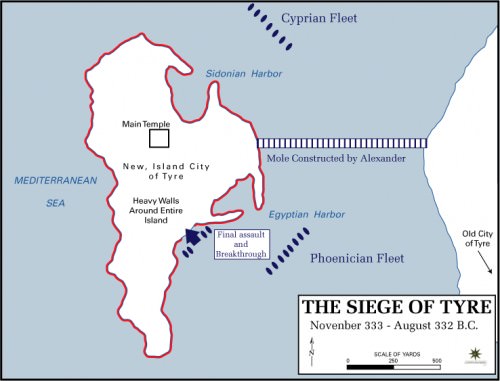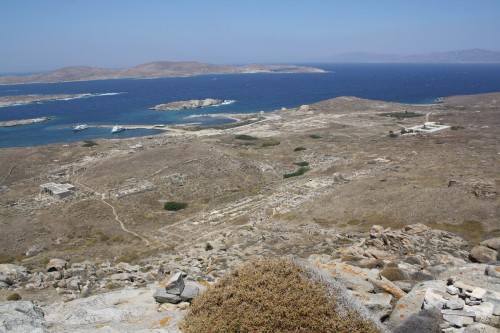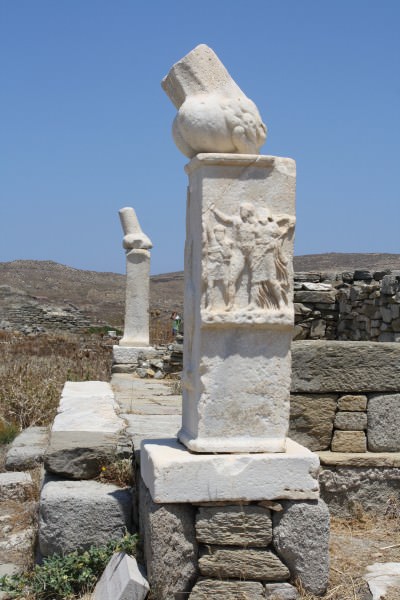Tyre › Delos » Ancient origins
Articles and Definitions › Contents
- Tyre › Antique Origins
- Delos › Antique Origins
Ancient civilizations › Historical and archaeological sites
Tyre › Antique Origins
Definition and Origins

Tyre is an ancient Phoenician port city which, in myth, is known as the birthplace of Europa (who gave Europe its name) and Dido of Carthage (who gave aid to, and fell in love with, Aeneas of Troy ). The name means 'rock' and the city consisted of two parts, the main trade centre on an island, and 'old Tyre', about a half mile opposite on the mainland. The old city, known as Ushu, was founded c. 2750 BCE and the trade centre grew up shortly after. In time, the island complex became more prosperous and populated than Ushu and was heavily fortified. The prosperity of Tyre attracted the attention of King Nebuchadnezzar II of Babylon who lay siege to the city for thirteen years in the 6th century BCE without breaking their defenses. During this siege most of the inhabitants of the mainland city abandoned it for the relative safety of the island city.Ushu became a suburb of Tyre on the mainland and remained so until the coming of Alexander the Great. The Tyrians were known as workers in dye from the shells of the Murex shellfish. This purple dye was highly valued and held royal connotations in the ancient world. It also gave the Phoenicians their name from the Greeks - Phoinikes - which means "purple people". The city-state was the most powerful in all of Phoenicia after surpassing its sister state Sidon. Tyre is referenced in the Bible in the New Testament where it is claimed that both Jesus and St. Paul visited the city and remains famous in military history for Alexander the Great's seige.
TYRE WAS IN ITS GOLDEN AGE AROUND THE 10TH CENTURY BCE AND, IN THE 8TH, COLONIZED OTHER SITES & ENJOYED GREAT PROSPERITY.
TYRE'S GOLDEN AGE
Tyre was in its golden age around the 10th century BCE and, in the 8th, was colonizing other sites in the area and enjoying great wealth and prosperity owing primarily to an alliance with Israel. The Tyrian alliance and trade agreement with David, King of Israel, was initiated by the King of Tyre, Abibaal who sent the new king timber from the fabled cedars of Lebanon (as Abibaal's son, Hiram, is said to have done for David's son Solomon ). This alliance resulted in a very lucrative partnership which benefited both parties. According to the historian Richard Miles, "Commercially, this deal not only gave Tyre privileged access to the valuable markets of Israel, Judaea, and northern Syria, it also provided further opportunities for joint overseas ventures. Indeed, a Tyrian-Israelite expedition travelled to the Sudan and Somalia, and perhaps even as far as the Indian Ocean" (32).
Another development which encouraged the wealth of Tyre seems to have been a religious revolution in the city under the reigns of Abibaal and Hiram which elevated the god known as Melqart (a deified version of Hercules ) over the traditional divine couple of the Phoenicians, Baal (also known as El) and Astarte (Asherah). The primacy of Melqart (whose name means `King of the City') drew power away from the priests of the traditional pantheon of the gods and placed it at the disposal of the palace. Richard Miles notes, "It seems that a desire to bring the temples to heel lay behind the royal decision to replace the traditional chief deities of Tyre with a new god, Melqart"(32). The result was not only an increase in the wealth of the palace but, through a more efficient distribution of that wealth, increased prosperity for the whole of the city.

Phoenician Trade Network
ALEXANDER THE GREAT & THE SIEGE
The king now, not the priests, was the "bridge between the temporal and celestial worlds, and the needs of the heavenly gods could closely correspond with the political exigencies of the palace" (Miles, 33). This new religious policy encouraged a more closely-knit bond among the people of the city by designating them as set apart from the other city-states of Phoenicia and, so, special in the eyes of their god. Miles writes:
The king even introduced an elaborate new ceremonial to celebrate the annual festival of Melqart. Each spring, in a carefully choreographed festival called the egersis, an effigy of the god was placed on a giant raft before being ritually burnt as it drifted out to sea while hymns were sung by the assembled crowds. For the Tyrians, as for many other ancient Near eastern peoples, the emphasis fell upon the restorative properties of fire, for the god himself was not destroyed but revived by the smoke, and the burning of the effigy thus represented rebirth. To emphasize the importance of the egersis in maintaining the internal cohesion of the Tyrian people, all foreigners had to leave the city for the duration of the ceremony (33-34).
It was this ceremony, and the importance it held for the people, which would bring about Tyre's destruction and the slaughter or enslavement of the populace. In 332 BCE, Alexander the Great arrived at the city, fresh from the subjugation of Sidon, and demanded Tyre's surrender. Following Sidon's lead, the Tyrians acknowledged Alexander's greatness and presented him with gifts. All seemed to be going well and, pleased with their submission, Alexander said he would present a sacrifice in honor of their god in the Temple of Melqart. The Tyrians could not allow this as it would be sacrilegious for a foreigner to present a sacrifice in the holy home of their god and even more so as the ceremony of the egersis was close at hand. The historian Worthington presents what followed: "Azemilk, King of Tyre, proposed a compromise. Tyre would become Alexander's ally, but he should sacrifice on the mainland at Old Tyre, opposite the island. An angry Alexander sent envoys to say this was unacceptable and that the Tyrians had to surrender. They murdered the envoys and threw them off their walls" (105).Alexander then ordered the siege of Tyre.

Siege of Tyre
He dismantled much of the old mainland city of Ushu as well as using fallen debris, rock, and felled trees, filling in the sea between the mainland and the island to create a land bridge for his war machines. Over the centuries since, this caused heavy sedimentation to occur and permanently linked the island to the mainland; which is why Tyre is not an island today. After a siege of seven months, Alexander used his man-made causeway to batter down the walls of Tyre and take the city. Tyre's 30,000 inhabitants were either massacred or sold into slavery, and the city was destroyed by Alexander in his rage at their having defied him for so long. The fall of Tyre led to the rise of Carthage as the survivors of the siege, who were able to escape Alexander's wrath by bribery or stealth, founded the new city in the north of Africa. Following Alexander's death in 323 BCE, his general Seleucus I took control of the region of Phoenicia, including Tyre, and rebuilt it but the city was again destroyed in 315 BCE by Alexander's rival general Antigonus.
THE COMING OF ROME & TYRE'S DECLINE
The Romans took the ruined city as a colony in 64 BCE, when Pompey annexed the whole of Phoenicia to the Roman Empire. Tyre was re-built under the Romans who, ironically, destroyed the city of Carthage the surviving Tyrians had founded.Rome built the roads, monuments, and aqueducts which can still be seen in the modern day and the city flourished under Roman rule but declined after the fall of the empire. It continued on as a port city under the eastern half of Rome, the Byzantine Empire, until the 7th century CE when it was taken in the Muslim conquest of the region.
MAP
Delos › Antique Origins
Definition and Origins

Delos is a Greek island in the Cyclades archipelago which was both an influential political force and, with its sanctuary to the god Apollo, an important religious centre in the Archaic and Classical periods. The island was also a major commercial and trading centre in the 2nd and 1st centuries CE.
DELOS IN MYTHOLOGY
Delos, measuring a mere 3 km², is a small island without any particular advantages for habitation due to its barrenness and lack of water. In Greek mythology, this is precisely why Leto, escaping the wrath of Hera, was able to find sanctuary here in order to give birth to Apollo and Artemis. In some versions of the myth, Zeus (Leto's lover) called on his brother Poseidon to create the island with a thrust of his trident, hence the name Delos, which signifies 'appearance' or 'apparent' in ancient Greek.The ancient Greeks also considered the island the centre of the Cycladic group and as the last resting place of the Hyperboreans - a legendary northern race of Apollo-worshippers.
THE ANCIENT GREEKS CONSIDERED THE ISLAND THE BIRTHPLACE OF APOLLO AND THE CENTRE OF THE CYCLADES ISLANDS.
HISTORICAL OVERVIEW
The island was first inhabited in the early Bronze Age, and Mycenaean tombs have been excavated dating from the late Bronze Age. Colonised from Ionia in the mid-10th century BCE, it was not, however, until the 8th century BCE that the site began to take on a religious significance in the wider Greek world. Athens, under Pisistratus, took a greater interest in the island in the 6th century BCE and attempted to purify the island by a 'catharsis' - removing and prohibiting burials on the island from c. 540 BCE.
Delos further increased its importance when it was chosen as the meeting place and treasury for the Delian League in 478 BCE. In 454 BCE the treasury was moved to Athens and the Athenians also took over administration of the site. Administration changed hands when Antigonus established the League of Islanders in 314 BCE, which included Delos.
Following the Chremonidean War (266-229 BCE), Delos became an independent polis for the next 150 years or so and was administered by a religious council of hieropoioi. In this period, the island enjoyed the generous patronage of various Hellenistic kings. The island's independence came to an end in 166 BCE when the Romans gave control of Delos back to Athens, also making it a free trade port. This brought another period of prosperity, and the island became an important centre for the slave trade whilst its population greatly increased in size and ethnic diversity, a fact reflected in the adoption of diverse religious cults on the island, such as those to Sarapis and Isis. Things took a turn for the worse, however, when the island was sacked first by Mithradates VI ’s general, Archelaus, in 88 BCE and then again by pirates in 69 BCE, events which brought about the island's gradual and permanent decline.

Delos Panorama
THE SANCTUARY OF DELOS
The island was first excavated by a team of French archaeologists from 1873 CE, revealing the true extent of the religious site.The island once had temples dedicated to Apollo (the Artemission), Leto (the Letoon), Artemis, Hera (the Heraion), Zeus, Athena, Hercules, and Asclepius. The Temple of Apollo housed, from the 6th century BCE, an 8 m high cult statue of the god made of wood and covered in gold. There was also a temple dedicated to the twelve Olympian gods (the Dodekatheon).Several other sacred buildings have also been identified but their exact purpose is unclear.
The Pan ēgyris, an Ionian festival in honour of Apollo, was held every year on the island and in the late 5th century BCE, a spectacular (Athenian inspired) festival - the Delia - was held every five years. The accompanying athletic games and musical and dancing contests attracted visitors from across the Aegean. Victors in the Delian games climbed the island's Mt. Kynthos in order to be crowned.
As with other major sanctuaries, Delos had a diverse complex of buildings, including a monumental gateway entrance ( propylaea ) to the site, a theatre (c. 300 BCE, capacity: 5,000 spectators), stadium, several stoas (for example, of Antigonus), gymnasium, hippodrome, palaestras (3rd and 2nd centuries BCE), a hippostyle hall (constructed in the 3rd century BCE) an agora (built under Theophrastus in the 2nd century BCE), and even a sacred lake, guarded by marble lions.

Column Phallus, Delos
Beyond the sanctuary of Apollo, there were also sanctuaries testimony to the city ’s one-time cosmopolitan make-up, with temples to Isis, Serapis and Cabeiri. Commercial buildings on the island included markets and warehouses, and the residential area dating from the 2nd century BCE displays grid street plans and large houses, which, with their mosaics, wall paintings, and colonnades, are testimony to the islands one-time prosperity.
Notable archaeological finds at the site are the famous marble lions, much weather-worn but still retaining a regal air. Of these, five lions survive from the original nine dedicated by the Naxians in the 7th century BCE. In addition, several fine mosaics have been uncovered, including one depicting Dionysos seated on a panther.
LICENSE:
Article based on information obtained from these sources:with permission from the Website Ancient History Encyclopedia
Content is available under License Creative Commons: Attribution-NonCommercial-ShareAlike 3.0 Unported. CC-BY-NC-SA License